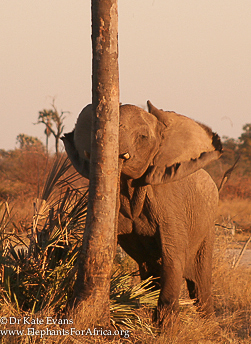
Hyena in the kitchen
August 5, 2010
Bush Birthday
November 21, 2010Bridget gets her daily fruit

On an afternoon research drive we are headed for the airstrip. On the way we came across to young males between the ages of 10 and 15 years who were standing side by side gently rubbing heads together. Unfortunately they were a little skittish, being so young, and soon moved off into the thicker vegetation. They crossed the road in front of us, and with the lovely light will able to get some good measurements and photographs of their footprints. Male elephants continue to grow throughout their lives, and it has been found in Asian and African elephants that the size of their feet is related to their height. So by measuring their feet we get a good idea of age. It is said that the footprint of an elephant is very individual, much like a human fingerprint and so we are starting to take photographs of the footprint to add to their ID files.
Once we had done that, we carried on with our route. Near airstrip we spotted an elephant shaking palm trees, I immediately concluded that it was a male elephant. As we got nearer to the individual I started questioning my decision as he looked remarkably like a female; with an angular forehead and breasts! But why was she alone? And did I really see her shaking the tree from the distance? With binoculars and camera at the ready I started to figure out the mystery. It was a female, and it was a female I know. It was Bridget, a dominant female of the B herd; in fact I thought she was the matriarch. We stood on top of the vehicle and had a good look around any other elephants, there were none to be seen or heard. As I pondered on why she was away from the rest of the herd, she did something I have never seen before. She  successfully shook a palm tree and got some nuts down. In the eight years I have been researching elephants in the Okavango Delta I’ve only ever seen an adult female trying to shake palm trees once before, and she was unsuccessful. So here was Bridget proving my conclusion wrong that female elephants can shake palm trees and get nuts down.
successfully shook a palm tree and got some nuts down. In the eight years I have been researching elephants in the Okavango Delta I’ve only ever seen an adult female trying to shake palm trees once before, and she was unsuccessful. So here was Bridget proving my conclusion wrong that female elephants can shake palm trees and get nuts down.
The palm nuts are seemingly a really important resource for the Male elephants of the Okavango Delta, as they spend a lot of time during the months of July and August (when they’re in fruit), shaking the palm trees. Until today I thought it was a resource that only males were able to harvest; how wrong I was!!
